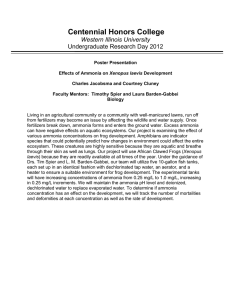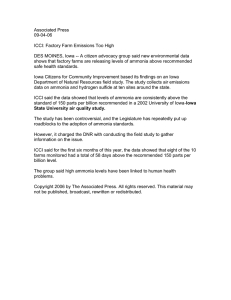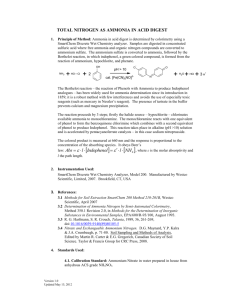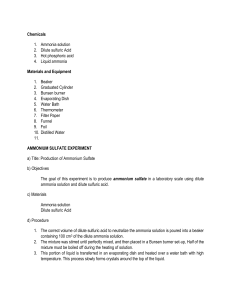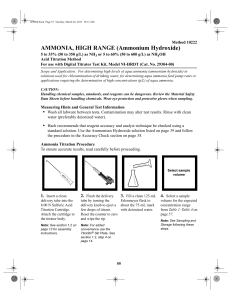Ammonia Safety Sheet: Hazards, Control, Emergency Action
advertisement
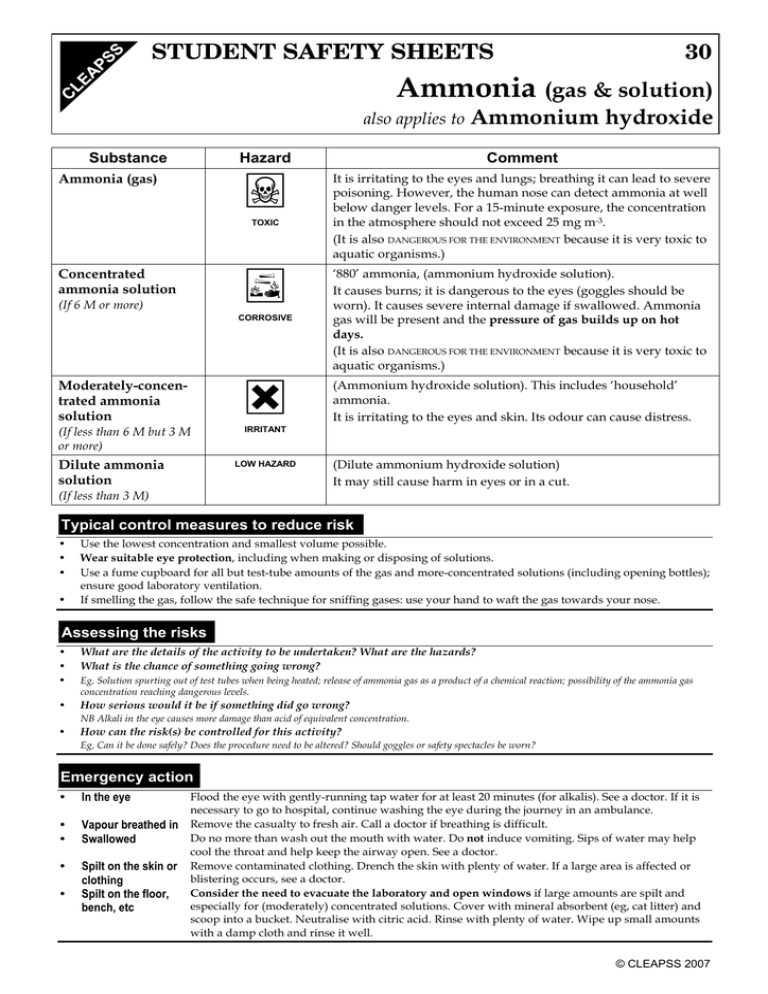
STUDENT SAFETY SHEETS 30 Ammonia (gas & solution) also applies to Substance Ammonia (gas) Hazard Comment T It is irritating to the eyes and lungs; breathing it can lead to severe poisoning. However, the human nose can detect ammonia at well below danger levels. For a 15-minute exposure, the concentration in the atmosphere should not exceed 25 mg m-3. (It is also DANGEROUS FOR THE ENVIRONMENT because it is very toxic to aquatic organisms.) TOXIC Concentrated ammonia solution C (If 6 M or more) CORROSIVE Moderately-concentrated ammonia solution I (If less than 6 M but 3 M or more) IRRITANT Dilute ammonia solution Ammonium hydroxide LOW HAZARD ‘880’ ammonia, (ammonium hydroxide solution). It causes burns; it is dangerous to the eyes (goggles should be worn). It causes severe internal damage if swallowed. Ammonia gas will be present and the pressure of gas builds up on hot days. (It is also DANGEROUS FOR THE ENVIRONMENT because it is very toxic to aquatic organisms.) (Ammonium hydroxide solution). This includes ‘household’ ammonia. It is irritating to the eyes and skin. Its odour can cause distress. (Dilute ammonium hydroxide solution) It may still cause harm in eyes or in a cut. (If less than 3 M) Typical control measures to reduce risk • • • • Use the lowest concentration and smallest volume possible. Wear suitable eye protection, including when making or disposing of solutions. Use a fume cupboard for all but test-tube amounts of the gas and more-concentrated solutions (including opening bottles); ensure good laboratory ventilation. If smelling the gas, follow the safe technique for sniffing gases: use your hand to waft the gas towards your nose. Assessing the risks • • • • What are the details of the activity to be undertaken? What are the hazards? What is the chance of something going wrong? Eg, Solution spurting out of test tubes when being heated; release of ammonia gas as a product of a chemical reaction; possibility of the ammonia gas concentration reaching dangerous levels. How serious would it be if something did go wrong? NB Alkali in the eye causes more damage than acid of equivalent concentration. • How can the risk(s) be controlled for this activity? Eg, Can it be done safely? Does the procedure need to be altered? Should goggles or safety spectacles be worn? Emergency action • In the eye • • Vapour breathed in Swallowed • Spilt on the skin or clothing Spilt on the floor, bench, etc • Flood the eye with gently-running tap water for at least 20 minutes (for alkalis). See a doctor. If it is necessary to go to hospital, continue washing the eye during the journey in an ambulance. Remove the casualty to fresh air. Call a doctor if breathing is difficult. Do no more than wash out the mouth with water. Do not induce vomiting. Sips of water may help cool the throat and help keep the airway open. See a doctor. Remove contaminated clothing. Drench the skin with plenty of water. If a large area is affected or blistering occurs, see a doctor. Consider the need to evacuate the laboratory and open windows if large amounts are spilt and especially for (moderately) concentrated solutions. Cover with mineral absorbent (eg, cat litter) and scoop into a bucket. Neutralise with citric acid. Rinse with plenty of water. Wipe up small amounts with a damp cloth and rinse it well. © CLEAPSS 2007



